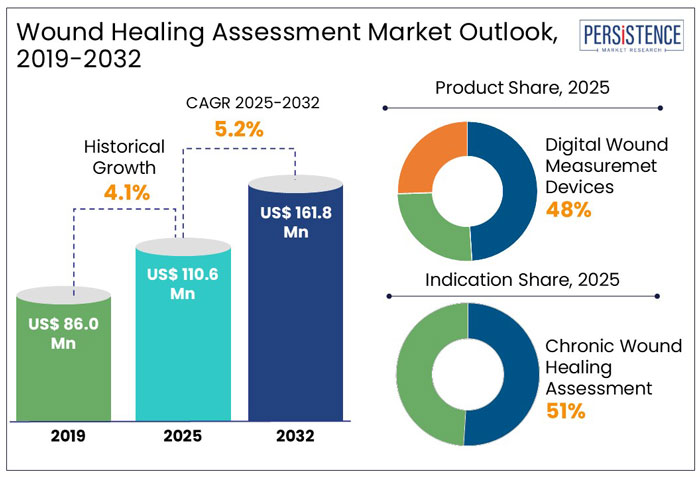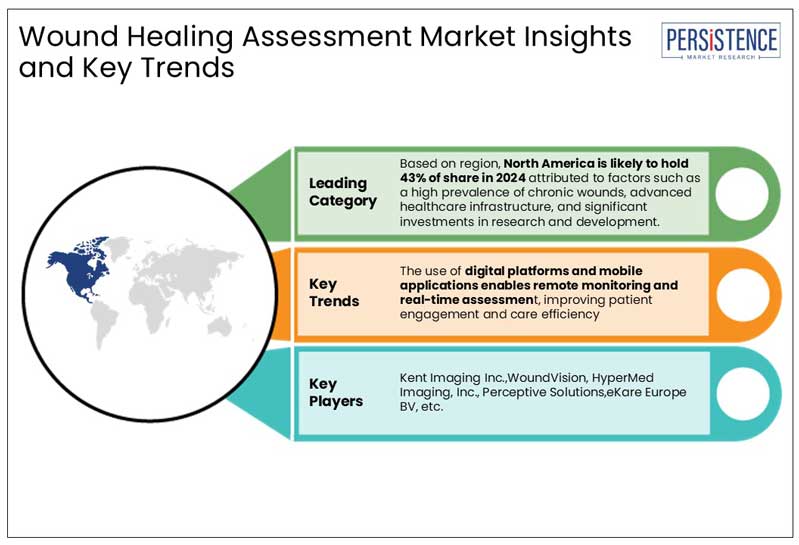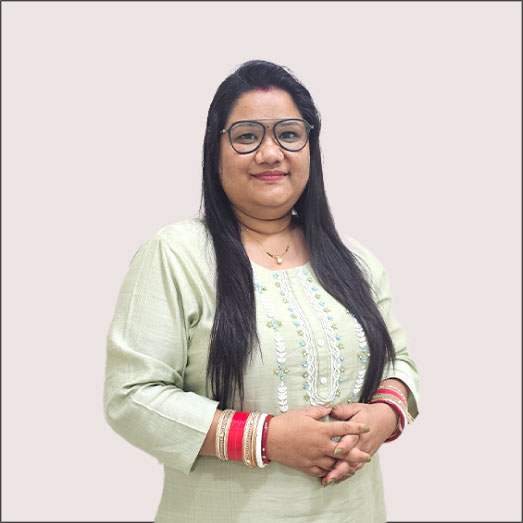Industry: Healthcare
Published Date: February-2025
Format: PPT*, PDF, EXCEL
Delivery Timelines: Contact Sales
Number of Pages: 290
Report ID: PMRREP26899
The global wound healing assessment market size is anticipated to rise from US$ 110.6 Mn in 2025 to US$ 161.8 Mn by 2032. It is projected to witness a CAGR of 5.2% from 2025 to 2032.
Wound care has evolved significantly from ancient remedies to modern medical advancements. Early civilizations, such as the Egyptians, Mayans, and Sumerians, developed innovative methods for treating wounds using natural substances and traditional techniques.
Hippocrates and Celsus later documented the foundations of systematic wound care, leading to scientific breakthroughs in infection control and healing processes by the late 19th and early 20th centuries.
In recent years, technological advancements have been at the heart of this transformation, from near-infrared spectroscopy to smart wound dressings, and these advancements are bringing hope to millions.
Non-invasive optical imaging modalities, such as near-infrared spectroscopy and fluorescence imaging, revolutionize wound care by enabling precise and real-time assessments. These tools not only enhance diagnostic accuracy but also significantly improve patient outcomes.
Effective wound assessment also considers various patient factors influencing the healing process, including age, mobility, comorbidities, and lifestyle habits.

Key Highlights of the Wound Healing Assessment Market
|
Global Market Attributes |
Key Insights |
|
Wound Healing Assessment Market Size (2025E) |
US$ 110.6 Mn |
|
Market Value Forecast (2032F) |
US$ 161.8 Mn |
|
Projected Growth (CAGR 2025 to 2032) |
5.2% |
|
Historical Market Growth (CAGR 2019 to 2024) |
4.1% |
Emergence of Non-Invasive Optical Imaging Technologies Aided Market's Growth between 2019 to 2024
During the historical period from 2019 to 2024, the wound healing assessment market was primarily driven by the growing burden of chronic wounds, such as diabetic ulcers and pressure injuries.
Traditional diagnostic methods relied heavily on visual inspections and subjective assessments. However, the emergence of non-invasive optical imaging technologies, like near-infrared spectroscopy (NIRS) and fluorescence imaging, began revolutionizing wound assessment, providing real-time insights into tissue viability and infection risks.
AI-Powered Wound Diagnostics to Play a Major Part in Market's Future Growth Outlook
Over the forecast period, the market is expected to witness exponential growth, driven by advancements in AI-powered wound diagnostics, smart wound dressings, and the integration of remote patient monitoring.
With the rise of telemedicine, healthcare providers can now assess wounds remotely, ensuring faster interventions and improved patient outcomes. The increasing prevalence of diabetes and an aging global population will further fuel demand for advanced wound care solutions, enhancing the market's growth.
Growth Drivers
Rising Burden of Chronic Wounds is a Major Market Driving Factor
Chronic wounds, including diabetic foot ulcers, pressure sores, and venous leg ulcers, have become a silent epidemic, affecting over 6.5 million people in the U.S. alone.
The problem is even more severe among elderly patients and individuals with vascular diseases, whose wounds take longer to heal due to poor circulation and weakened immune systems.
Hospitals, clinics, and wound care centers are turning to AI-powered diagnostics, smart wound dressings, and non-invasive imaging technologies to monitor healing in real-time.
As these tools become more precise and widely adopted, healthcare providers can detect infection risks earlier, leading to faster treatments, reduced amputations, and improved patient outcomes. This urgent need for better wound care solutions is fueling rapid market expansion.
Lack of Skilled Professionals for Advanced Wound Assessment is a Major Setback for the Market
Digital wound imaging, hyperspectral analysis, and AI-powered wound diagnostics require specialized knowledge, yet many healthcare workers haven’t received the necessary training. Even the most advanced wound care technologies can go underutilized without skilled professionals; such a skills gap is a major growth restraint for the market.
While leading hospitals in North America and Europe have the infrastructure to train their staff, many rural clinics and developing healthcare systems struggle to keep up.
The shortage of wound care specialists means that even with state-of-the-art wound healing assessment solutions, accurate diagnosis and treatment planning may still be delayed or inconsistent. Unless medical training programs prioritize wound care technology, the full potential of AI-driven wound diagnostics and smart healing devices may remain untapped.
Rise of Telemedicine and Remote Wound Monitoring Propels Market Growth Prospects
For patients suffering from chronic diseases or patients recovering from surgery, frequent hospital visits for wound check-ups were exhausting. But thanks to telemedicine and remote wound monitoring, such patients have their wounds assessed from the comfort of their homes.
The shift in healthcare delivery opens up immense opportunities in the wound healing assessment market, making specialized care more accessible.
Using high-resolution imaging, AI-powered wound-tracking apps, and cloud-based health records, doctors can remotely evaluate wounds, suggest treatment modifications, and ensure that healing is on track without requiring in-person visits.
It particularly benefits patients in rural areas, nursing homes, and post-operative care settings, where frequent travel can burden them. With telehealth adoption growing rapidly, remote wound monitoring will soon become a cornerstone of modern wound care, bridging the gap between patients and healthcare professionals in real time.
Product Insights
Digital Wound Measurement Devices Leads the Product Segmentation with 48% Market Share
Digital wound measurement devices have transformed how healthcare providers assess and monitor wounds, moving from subjective visual inspections to data-driven, high-precision diagnostics.
Imagine a nurse in a busy hospital trying to track the healing progress of a diabetic foot ulcer. In the past, wound size and depth were manually measured, often leading to inconsistencies. Today, digital wound measurement devices use high-resolution imaging and 3D technology to provide precise wound dimensions, tissue analysis, and healing trends, all in real time.
It enhances patient care and allows for earlier intervention, reducing complications and hospital readmissions. As healthcare shifts towards AI-powered solutions and remote monitoring, these devices have become indispensable tools in hospitals, wound care clinics, and home care settings.
With chronic wounds rising globally, digital wound measurement devices are setting new standards in personalized, technology-driven wound management, making healing more efficient.
Indication Insights
Rising Prevalence of Diabetes and a Growing Aging Population Make Chronic Wound Healing Assessment Lead the Indication Segment with 51% Share
With an aging population, increasing diabetes cases, and a surge in pressure ulcers, the need for chronic wound assessment technologies has never been greater.
Chronic wounds, unlike acute wounds, persist for weeks or months, often due to underlying health conditions such as diabetes, vascular diseases, and immune disorders. As the global burden of chronic wounds continues to rise, the market for chronic wound assessment solutions is set to grow exponentially.
Governments and healthcare providers are investing heavily in advanced diagnostics, remote wound management, and AI-integrated solutions to reduce hospitalizations and improve patient outcomes, which eventually aids the market’s growth.

Growing Number of Diabetic Patients in North America Leads the Region to Accumulate 43% of the Global Share
In the ever-evolving world of healthcare, North America has emerged as a dominant region in the wound healing assessment market, holding an impressive 43% share of the global industry.
A growing number of diabetes patients, increased surgical interventions, and a rising demand for advanced wound care solutions fuel the North American leadership.
At the heart of the region's growth is the United States, which commands a staggering 90% of North America's wound healing assessment revenue in 2024. With its cutting-edge healthcare infrastructure, the U.S.'s strong presence of leading wound care companies and well-established import-export networks keep the market thriving.
Beyond its economic strength, the U.S. is a global destination for patients seeking state-of-the-art wound diagnostics and treatment.
With AI-powered wound assessment tools, smart wound dressings, and non-invasive imaging technologies, the country continues to set new standards in patient care. Government initiatives to enhance healthcare accessibility further accelerate this momentum, ensuring that the future of wound healing assessment in North America remains brighter than ever.
Europe to Witness Surge in Demand for Advanced Wound Healing Assessment Solutions
Healthcare providers in Europe are witnessing a steady rise in the demand for advanced wound healing assessment solutions.
With an aging population and a growing prevalence of diabetes-related wounds, pressure ulcers, and post-surgical infections, countries like Germany, France, and the UK are investing heavily in AI-powered diagnostics, smart wound dressings, and non-invasive imaging technologies.
Germany, often regarded as the medical technology hub of Europe, is at the forefront of wound care innovation, leveraging optical imaging and telemedicine to enhance patient outcomes.
France and the UK follow closely, with government-backed initiatives to improve chronic wound management through digitized patient monitoring and real-time wound assessment tools.
Across the continent, healthcare policies promoting remote patient monitoring are playing a crucial role in early wound detection and intervention, ultimately reducing treatment costs and improving patient experiences.
Asia Pacific to Witness Fastest Growth Owing to the Highest Number of Diabetes Patients
The Asia Pacific wound healing assessment market is evolving at a rapid pace, accumulating a substantial share of the global market revenue. With the highest diabetes population in the world, countries like China, India, and Japan are seeing a surge in chronic wounds, diabetic foot ulcers, and surgical site infections.
The growing burden is pushing healthcare systems to adopt next-generation wound assessment technologies, including near-infrared spectroscopy (NIRS), AI-powered wound analytics, and regenerative medicine solutions.
China is leading the charge with state-sponsored healthcare reforms to make advanced wound care accessible to millions. The country is embracing robotic wound treatment and smart dressings infused with nanotechnology, bringing futuristic solutions to the present.
India, on the other hand, is experiencing a boom in telemedicine adoption, enabling rural healthcare providers to assess and manage wounds remotely using AI-driven mobile applications.
The region's rapid urbanization, increased healthcare spending, and rising awareness of modern wound care solutions are fuelling exponential growth in the Asia Pacific wound healing assessment market.
In the rapidly evolving wound healing assessment market, competition is fierce as global healthcare giants and innovative startups push the boundaries of technology.
Major players in the market dominate the industry, leveraging AI-powered diagnostics, smart wound dressings, and non-invasive imaging technologies to enhance patient outcomes.
Meanwhile, emerging players like Swift Medical and Tissue Analytics are making waves with AI-driven mobile wound assessment apps, offering real-time insights to clinicians worldwide.
As governments emphasize remote patient monitoring and telemedicine, companies are racing to develop next-gen wound care solutions. With chronic wounds rising globally, the market is no longer just about treatment; it’s about precision, prevention, and personalized care, making innovation the ultimate battleground.
Key Industry Developments
|
Report Attributes |
Details |
|
Historical Data/Actuals |
2019 - 2024 |
|
Forecast Period |
2025 - 2032 |
|
Market Analysis Units |
Value: US$ Bn/Mn, Volume: As applicable |
|
Geographical Coverage |
|
|
Segmental Coverage |
|
|
Competitive Analysis |
|
|
Report Highlights |
|
|
Customization and Pricing |
Available upon request |
By Product
By Indication
By Technology
By End User
By Region
To know more about delivery timeline for this report Contact Sales

The market is set to reach US$ 110.6 Mn in 2025.
Kent Imaging Inc., WoundVision, HyperMed Imaging, Inc., are a few leading players.
The industry is estimated to rise at a CAGR of 5.2% through 2032.
North America is projected to hold the largest share of the industry in 2025.
The market for is anticipated to reach a valuation of US$ 161.8 million by 2032.